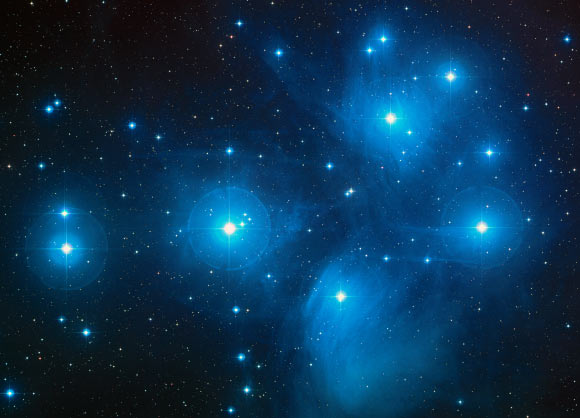Also known as the Seven Sisters and Messier 45, the Pleiades — an open star cluster about 440 light-years from Earth in the constellation of Taurus — constitutes the bound core of a much larger structure that contains multiple known clusters distributed over 600 parsecs (1,950 light-years). Dubbed the Greater Pleiades Complex, this structure contains at least 3,091 stars.
Stars are born in clouds of dust and gas. Pockets of this material clump together, eventually collapsing in on themselves to create what becomes a star’s hot core.
Star formation often happens in bursts, with many stars forming in close proximity and succession.
Groups of stars that formed in the same molecular cloud are called a cluster.
They remain gravitationally bound to each other for many millennia.
Eventually — tens to hundreds of millions of years after their formation — the star-forming material from which they emerged is ejected from their vicinity by cosmic winds, radiation, and other astrophysical phenomena.
When this occurs, individual stars dissolve into their host galaxy and it can be extremely challenging to identify their relationships and trace the chronology of their origin story, especially after 100 million or more years have passed.
In new research, Dr. Luke Bouma from the Observatories of the Carnegie Institution for Science and colleagues focused on the Pleiades.
Using data collected by NASA’s TESS mission, ESA’s Gaia spacecraft, and the Sloan Digital Sky Survey (SDSS), they found that this star cluster constitutes the core of a much larger structure of related stars that are distributed over more than 1,950 light-years.
“We are calling this the Greater Pleiades Complex,” Dr. Bouma said.
“It contains at least three previously known groups of stars, and likely two more.”
“We were able to determine that most of the members of this structure originated in the same giant stellar nursery.”
The key to their approach is the fact that the speed of a star’s rotation slows as it ages.
Their work leveraged a combination of stellar rotation observations from TESS (which was designed to identify exoplanets that transit in front of their host stars) and observations of stellar motion from Gaia (which was designed to map our Milky Way Galaxy).
Using this information, they developed a new rotation-based way to single out and identify stars that share an origin story.
“It was only by combining data from Gaia, TESS, and SDSS that we were able to confidently identify new members of the Pleiades,” Dr. Bouma said.
“On their own, the data from each mission were insufficient to reveal the full extent of the structure.”
“But when we integrated them — linking stellar motions from Gaia, rotations from TESS, and chemistry from SDSS — a coherent picture emerged.”
“It was like assembling a jigsaw puzzle, where each dataset provided a different piece of the larger puzzle.”
Beyond having similar ages, the authors demonstrated that the stars in the Greater Pleiades Complex have similar chemical compositions, and that the stars used to be closer together.
The data from the SDSS’ fifth generation were used for chemical abundance analysis.
“The Pleiades has played a central role in human observations of the stars since antiquity,” Dr. Bouma said.
“This work marks a big step toward understanding how the Pleiades has changed since it was born one hundred million years ago.”
According to the team, their new findings have broad implications.
The Pleiades is not only an astrophysical benchmark for young stars and exoplanets but also a cultural touchstone featured worldwide in the Old Testament and Talmud, celebrated as Matariki in New Zealand, and even represented by the logo of Subaru in Japan.
“We’re realizing that many stars near the Sun are part of massive extended stellar families with complex structures,” said University of North Carolina at Chapel Hill’s Professor Andrew Mann.
“Our work provides a new way to uncover these hidden relationships.”
A paper on the findings was published this week in the Astrophysical Journal.
_____
Andrew W. Boyle et al. 2025. Lost Sisters Found: TESS and Gaia Reveal a Dissolving Pleiades Complex. ApJ 994, 24; doi: 10.3847/1538-4357/ae0724


![The image shows NGC 1866 superimposed with a false color image from the MUSE data cube, where the ionized shell of the planetary nebula Ka LMC 1 is seen as a red ring. The grayscale insets illustrate the different size of the ionized shells of singly ionized nitrogen [N II] and doubly ionized oxygen [O III]. The magnified Hubble image near the center of the ring reveals the presence of a pale blue star -- most probably the hot central star of Ka LMC 1. Image credit: AIP / M.M. Roth / NASA / ESA / Hubble.](https://cdn.sci.news/images/2025/11/image_14348-Ka-LMC-1-104x75.jpg)





